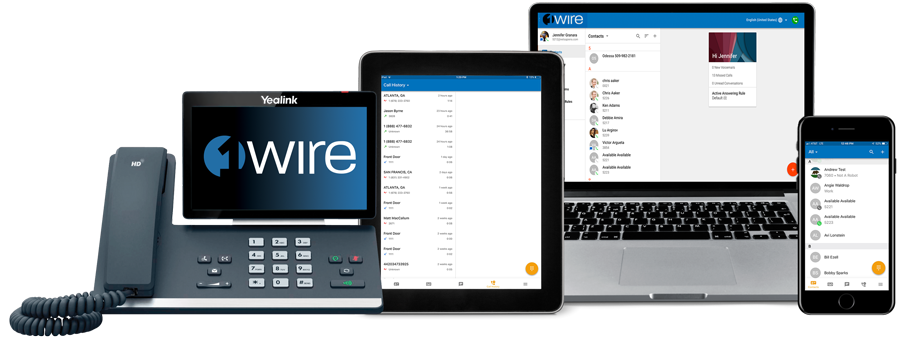Welcome to our comprehensive guide on Unified Communications. In today’s fast-paced and interconnected world, effective communication is paramount for businesses to thrive. Unified Communications (UC) provides a powerful solution by integrating various communication channels onto a single platform. This guide will delve into the intricacies of UC, exploring its features, benefits, and how it can revolutionize the way organizations communicate.
Whether you’re a small business owner looking to streamline your operations or a large corporation aiming to enhance collaboration across dispersed teams, this guide will equip you with the knowledge and insights needed to make informed decisions. From VoIP (Voice over Internet Protocol) to video conferencing, instant messaging to file sharing, UC encompasses a wide range of tools that empower organizations to communicate more efficiently and effectively.
Throughout this guide, we’ll discuss the different components of UC, including unified messaging, presence technology, and mobility solutions. We’ll also explore the potential challenges and considerations to keep in mind when implementing UC.
Join us as we navigate the world of Unified Communications and discover how it can propel your business forward. Get ready to unlock unparalleled communication capabilities and revolutionize the way you connect.

What is unified communications?
Unified Communications, often abbreviated as UC, refers to the integration of various communication tools and platforms into a single unified system. It combines real-time communication channels like voice and video calls, instant messaging, and conferencing with non-real-time communication channels such as email, voicemail, and fax. By consolidating these channels, UC enables seamless communication and collaboration, allowing individuals and teams to connect and work together regardless of their physical location.
The primary goal of unified communications is to enhance productivity, streamline workflows, and improve overall communication efficiency. With UC, individuals can seamlessly switch between different communication channels, access their messages and files from any device, and collaborate in real-time, fostering a more connected and efficient work environment.
Unified communications can be implemented through on-premises hardware, cloud-based solutions, or a hybrid approach that combines both. The choice of implementation depends on the organization’s specific needs, budget, and infrastructure.

The evolution of unified communications
Unified Communications has come a long way since its inception. It has evolved from traditional telephony systems to incorporate a wide range of communication tools and technologies. In the past, businesses relied on separate systems for voice calls, email, instant messaging, and video conferencing. These disparate systems often resulted in inefficiencies, increased costs, and a fragmented user experience.
However, with the advancements in technology and the rise of the internet, the concept of unified communications emerged. The integration of voice and data networks, the adoption of IP-based communication protocols, and the development of cloud computing paved the way for a more unified and seamless communication experience.
Today, unified communications solutions offer a comprehensive suite of communication tools, including voice and video calling, instant messaging, presence technology, conferencing, file sharing, and more. These tools are designed to work seamlessly together, providing users with a cohesive and intuitive communication experience.

Benefits of unified communications
Unified Communications offers numerous benefits for businesses of all sizes and industries. Let’s explore some of the key advantages of implementing a unified communications solution:
1. Increased productivity: UC streamlines communication and collaboration processes, reducing the time spent switching between different tools and platforms. With all communication channels integrated into a single system, employees can access and manage their messages, files, and contacts from a centralized interface, saving time and effort.
2. Enhanced collaboration: Unified Communications fosters collaboration among team members regardless of their physical location. With features like video conferencing, screen sharing, and instant messaging, employees can collaborate in real-time, exchange ideas, and work together on projects, regardless of where they are located.
3. Improved customer service: UC enables organizations to provide better customer service by ensuring that customer inquiries are promptly addressed and resolved. Features like unified messaging, call routing, and presence technology allow customer service representatives to access customer information and communicate with customers more effectively, resulting in improved customer satisfaction.
4. Cost savings: By consolidating communication tools onto a single platform, organizations can reduce costs associated with multiple vendors, maintenance, and infrastructure. Additionally, the adoption of cloud-based unified communications solutions eliminates the need for expensive on-premises hardware, reducing capital expenditures.
5. Flexibility and mobility: With unified communications, employees can stay connected and productive from anywhere, at any time. Mobile applications and softphone clients enable employees to access their communication tools and collaborate on the go, whether they are working from home, traveling, or at a client’s site.
Unified Communications offers numerous other benefits, including scalability, disaster recovery capabilities, and improved business continuity. The specific advantages will vary depending on the organization’s needs and the features offered by the chosen UC solution.

Unified communications statistics
The growing popularity of Unified Communications is evident from the following statistics:
1. A survey conducted by Nemertes Research found that organizations with unified communications solutions experienced an average of 20% increase in productivity.
2. According to a report by Grand View Research, the global unified communications market is projected to reach a value of $167.1 billion by 2025, growing at a CAGR of 16.8% from 2019 to 2025.
3. A study conducted by Frost & Sullivan revealed that companies that implemented unified communications solutions experienced an average cost reduction of 20-30% in their communication expenses.
4. A survey conducted by Osterman Research found that 84% of organizations saw an increase in employee efficiency and productivity after implementing unified communications.
These statistics highlight the significant impact that unified communications can have on businesses, both in terms of productivity gains and cost savings.

Components of unified communications
Unified Communications encompasses various components that work together to provide a seamless communication experience. Let’s explore some of the key components:
1. Unified messaging: Unified messaging combines multiple messaging channels into a single interface, allowing users to access and manage their email, voicemail, and fax messages from a unified mailbox. This eliminates the need to check multiple platforms and enhances productivity.
2. Presence technology: Presence technology allows users to see the availability and status of their colleagues in real-time. It provides information on whether a person is available, busy, away, or in a meeting, enabling users to make informed decisions about the best communication channel to use.
3. Mobility solutions: Mobility solutions enable users to access their communication tools and collaborate on the go. Mobile applications and softphone clients allow employees to make and receive calls, access voicemail, participate in video conferences, and send instant messages from their smartphones or tablets.
4. Conferencing and collaboration tools: Unified Communications offers various conferencing and collaboration tools, including audio conferencing, video conferencing, screen sharing, and document collaboration. These tools enable teams to collaborate in real-time, regardless of their physical location, fostering effective communication and teamwork.
5. Contact center integration: Unified communications solutions can integrate with contact center software to enhance customer service capabilities. This integration allows customer service representatives to access customer information, manage calls efficiently, and provide personalized support.
Each component plays a crucial role in creating a unified and seamless communication experience for organizations.

Choosing the right unified communications solution
Selecting the right unified communications solution is crucial to ensure a successful implementation. Here are some factors to consider when choosing a UC solution:
1. Scalability: Consider the scalability of the solution to accommodate future growth. Ensure that the solution can easily scale to meet the changing needs of your organization.
2. Features and functionality: Evaluate the features and functionality offered by the UC solution to ensure they align with your organization’s requirements. Consider the communication channels, collaboration tools, and integrations that are essential for your business.
3. Ease of use: The UC solution should be intuitive and user-friendly to encourage adoption and minimize training requirements. Consider the user interface, ease of navigation, and availability of mobile applications.
4. Security and compliance: Evaluate the security measures implemented by the UC solution provider to protect sensitive communications and data. Ensure that the solution complies with industry regulations and standards.
5. Integration capabilities: Consider the ability of the UC solution to integrate with other business applications and systems, such as CRM software, contact center solutions, and productivity tools. Integration capabilities enable seamless communication and data exchange across different platforms.
6. Vendor reliability and support: Choose a reputable vendor with a track record of delivering reliable solutions and excellent customer support. Consider factors like the vendor’s financial stability, customer reviews, and the availability of ongoing support and maintenance.
A thorough evaluation of these factors will help you select a unified communications solution that aligns with your organization’s needs and goals.

Implementing unified communications in your organization
Implementing unified communications requires careful planning and execution to ensure a smooth transition. Here are some key steps to consider:
1. Assess your current communication infrastructure: Evaluate your existing communication infrastructure, including hardware, software, and network capabilities. Identify any gaps or areas that need improvement to support unified communications.
2. Define your objectives and requirements: Clearly define your objectives and requirements for implementing unified communications. Determine the specific features and functionality you need to achieve your goals.
3. Choose the right deployment model: Decide whether an on-premises, cloud-based, or hybrid deployment model is best suited for your organization. Consider factors like cost, scalability, security, and maintenance requirements.
4. Select a reliable vendor: Choose a reputable vendor that offers a unified communications solution that meets your requirements. Consider factors like vendor reliability, solution features, integration capabilities, and ongoing support.
5. Plan the implementation process: Develop a comprehensive implementation plan that outlines the necessary steps, timelines, and responsibilities. Consider factors like user training, data migration, and integration with existing systems.
6. Test and evaluate: Conduct thorough testing of the unified communications solution before rolling it out to your organization. Identify and address any issues or challenges during the testing phase.
7. Train and educate users: Provide comprehensive training and educational resources to ensure smooth adoption of the unified communications solution. Train users on the features, functionality, and best practices for using the solution effectively.
8. Monitor and optimize: Continuously monitor and optimize the unified communications solution to ensure it meets your organization’s evolving needs. Collect feedback from users and make necessary adjustments and improvements.
By following these steps, you can successfully implement unified communications in your organization and reap the benefits of enhanced communication and collaboration.

Best practices for successful unified communications
To maximize the benefits of unified communications, consider the following best practices:
1. Define clear communication policies: Establish clear guidelines and policies for using unified communications tools. Communicate expectations regarding response times, appropriate use of different communication channels, and availability settings.
2. Encourage adoption and training: Promote the adoption of unified communications tools by providing comprehensive training and resources. Educate users on the benefits and best practices for using the tools effectively.
3. Promote cross-department collaboration: Foster collaboration and knowledge sharing across different departments and teams. Encourage the use of unified communications tools to facilitate communication and collaboration among employees.
4. Regularly review and update the system: Continuously review and update your unified communications system to ensure it meets the changing needs of your organization. Stay informed about new features, security updates, and enhancements provided by the vendor.
5. Monitor and analyze usage data: Monitor and analyze usage data to gain insights into communication patterns and identify areas for improvement. Use analytics to optimize workflows, identify bottlenecks, and enhance efficiency.
By following these best practices, you can maximize the value of your unified communications investment and create a more connected and collaborative work environment.

Unified communications for remote work
Unified communications plays a crucial role in enabling effective communication and collaboration for remote workers. With the rise of remote work, organizations need tools that facilitate seamless communication and collaboration among geographically dispersed teams. Unified communications provides the necessary tools and capabilities to bridge the gap and ensure efficient remote work.
1. Real-time communication: Unified communications tools like video conferencing, instant messaging, and voice calls enable remote workers to communicate in real-time, fostering effective collaboration and reducing the feeling of isolation.
2. Document collaboration: Unified communications solutions often include document collaboration features that allow remote workers to work together on shared files in real-time. This eliminates the need for multiple versions of the same document and enhances productivity.
3. Presence technology: Presence technology allows remote workers to see the availability and status of their colleagues, regardless of their physical location. This helps remote workers determine the best time and communication channel to reach their colleagues.
4. Mobile applications: Unified communications solutions usually offer mobile applications that enable remote workers to access their communication tools from smartphones or tablets. This allows them to stay connected and productive while on the go.
Unified communications tools empower remote workers by providing seamless communication and collaboration capabilities, ensuring that they can work effectively regardless of their location.

Unified communications and collaboration tools
Unified communications and collaboration (UCC) tools go hand in hand. UCC tools enhance communication and collaboration by integrating multiple tools into a single platform. These tools enable teams to work together, communicate, and share information in real-time. Here are some common UCC tools:
1. Video conferencing: Video conferencing allows teams to conduct face-to-face meetings remotely. It enables participants to see each other, share screens, and collaborate on documents in real-time.
2. Instant messaging: Instant messaging provides a quick and efficient way to communicate with team members. It allows for real-time conversations, file sharing, and group chats.
3. File sharing and document collaboration: File sharing and document collaboration tools enable teams to share files, edit documents simultaneously, and track changes. This ensures that everyone is working on the latest version of a file and facilitates collaborative work.
4. Project management tools: Project management tools help teams organize and manage their projects effectively. They provide features for task management, progress tracking, and team collaboration.
5. Team collaboration platforms: Team collaboration platforms bring together various UCC tools and provide a centralized hub for communication and collaboration. They often include features like chat, document sharing, task management, and integration with other business applications.
Unified communications and collaboration tools enable teams to work together seamlessly, regardless of their physical location, fostering effective communication and collaboration.

Unified communications security and compliance
Security and compliance are critical considerations when implementing unified communications. Here are some key aspects to address:
1. Data encryption: Ensure that your unified communications solution encrypts data in transit and at rest to protect sensitive information from unauthorized access.
2. Access controls: Implement robust access controls to prevent unauthorized users from accessing your unified communications system. Use strong passwords, multi-factor authentication, and role-based access controls to secure user accounts.
3. Firewalls and intrusion detection systems: Deploy firewalls and intrusion detection systems to protect your unified communications system from external threats. Regularly update and patch these security measures to stay protected against emerging vulnerabilities.
4. Compliance with regulations: Ensure that your unified communications solution complies with relevant industry
Get started with 1Wire unified communications
Amid the array of options, 1Wire emerges as the pinnacle choice for unified communications. Its multifaceted approach seamlessly integrates real-time communication tools like video conferencing, instant messaging, and voice calls, creating an environment where remote workers can interact as though they were in the same room. The prowess of 1Wire extends further through its document collaboration features, ensuring that team members can collectively contribute to shared files, eliminating redundancy and enhancing overall productivity.



